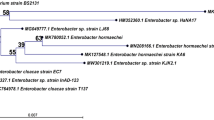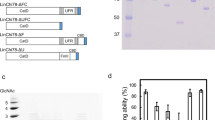Abstract
ORF69 in the cyanophage infecting Microcystis aeruginosa, Ma-LMM01, shows homology to the family 19 chitinases where the catalytic domain has structural similarity to lysozyme. Chitinases hydrolyze chitin, a β-1, 4-linked monopolymer of N-acetylglucosamine (GlcNAc); whereas lysozymes hydrolyzes peptidoglycan, alternating β-1, 4-linked copolymers of N-acetylmuramic acid (MurNAc) and GlcNAc. Using amino acid sequence comparison to ORF69, the putative sugar binding residues, Gln162 and Lys165, from the barley chitinase (the model enzyme for the family 19 chitinases) corresponding to subsites −4 and −3 were found to be replaced with Gly209 and Ile213, respectively, in ORF69. To analyze their contribution to substrate binding affinity, ORF69 was cloned into Escherichia coli; and two mutant proteins G209Q and I213K were prepared using site-directed mutagenesis. The wild-type gene product (gp69) showed both lysozyme and chitinase activities. In contrast, the I213K mutant showed a decrease (70%) in lysozyme activity and a significant increase (50%) in chitinase activity; whereas, the G209Q mutant almost completely abolished both enzyme activities. The data suggest the Ile213 residue is involved in recognizing the substrate MurNAc; and Gly209 has significant contribution in chitinase and lysozyme activities for the wild-type gp69.


Similar content being viewed by others
References
Codd GA, Lindsay J, Young FM, Morrison LF, Metcalf JS (2005) Harmful cyanobacteria. In: Huisman J et al (eds) Harmful cyanobacteria. Springer, Netherlands, pp 1–23
Yoshida T, Takashima Y, Tomaru Y, Shirai Y, Takao Y, Hiroishi S, Nagasaki K (2006) Isolation and characterization of a cyanophage infecting the toxic cyanobacterium Microcystis aeruginosa. Appl Environ Microbiol 72:1239–1247
Yoshida T, Nagasaki K, Takashima Y, Shirai Y, Tomaru Y, Takao Y, Sakamoto S, Hiroishi S, Ogata H (2008) Ma-LMM01 infecting toxic Microcystis aeruginosa illuminates diverse cyanophage genome strategies. J Bacteriol 190:1762–1772
Lavigne R, Darius P, Summer EJ, Seto D, Mahadevan P, Nilsson AS, Ackermann HW, Kropinski AM (2009) Classification of Myoviridae bacteriophages using protein sequence similarity. BMC Microbiol 9:224
Monzingo AF, Marcotte EM, Hart PJ, Robertus JD (1996) Chitinases, chitosanases, and lysozymes can be divided into procaryotic and eucaryotic families sharing a conserved core. Nat Struct Biol 3:133–140
Henrissat B (1991) A classification of glycosyl hydrolases based on amino acid sequence similarities. Biochem J 280:309–316
Henrissat B, Bairoch A (1993) New families in the classification of glycosyl hydrolases based on amino acid sequence similarities. Biochem J 293:781–788
Kawase T, Saito A, Sato T, Kanai R, Fujii T, Nikaidou N, Miyashita K, Watanabe T (2004) Distribution and phylogenetic analysis of family 19 chitinases in Actinobacteria. Appl Environ Microbiol 70:1135–1144
Nakayama K, Takashima K, Ishihara H, Shinomiya T, Kageyama M, Kanaya S, Ohnishi M, Murata T, Mori H, Hayashi T (2000) The R-type pyocin of Pseudomonas aeruginosa is related to P2 phage, and the F-type is related to lambda phage. Mol Microbiol 38:213–231
Mavrodi DV, Loper JE, Paulsen IT, Thomashow LS (2009) Mobile genetic elements in the genome of the beneficial rhizobacterium Pseudomonas fluorescens Pf-5. BMC Microbiol 9:8
Hart PJ, Pfluger HD, Monzingo AF, Hollis T, Robertus JD (1995) The refined crystal structure of an endochitinase from Hordeum vulgare L. seeds at 1.8 A resolution. J Mol Biol 248:402–413
Hahn M, Hennig M, Schlesier B, Hohne W (2000) Structure of jack bean chitinase. Acta Cryst D56:1096–1099
Kezuka Y, Ohishi M, Itoh Y, Watanabe J, Mitsutomi M, Watanabe T, Nonaka T (2006) Structural studies of a two-domain chitinase from Streptomyces griseus HUT6037. J Mol Biol 358:472–484
Hoell IA, Dalhus B, Heggset EB, Aspmo SI, Eijsink VG (2006) Crystal structure and enzymatic properties of a bacterial family 19 chitinase reveal differences from plant enzymes. FEBS J 273:4889–4900
Kurokawa Y, Yanagi H, Yura T (2001) Overproduction of bacterial protein disulfide isomerase (DsbC) and its modulator (DsbD) markedly enhances periplasmic production of human nerve growth factor in Escherichia coli. J Biol Chem 276:14393–14399
Bradford MM (1976) A rapid and sensitive method for the quantitation of microgram quantities of protein utilizing the principle of protein-dye binding. Anal Biochem 72:248–254
Wang SL, Chang WT (1997) Purification and characterization of two bifunctional chitinases/lysozymes extracellularly produced by Pseudomonas aeruginosa K-187 in a shrimp and crab shell powder medium. Appl Environ Microbiol 63:380–386
Honda Y, Taniguchi H, Kitaoka M (2008) A reducing-end-acting chitinase from Vibrio proteolyticus belonging to glycoside hydrolase family 19. Appl Microbiol Biotechnol 78:627–634
Marchler-Bauer A, Anderson JB, Chitsaz F, Derbyshire MK, DeWeese-Scott C, Fong JH, Geer LY, Geer RC, Gonzales NR, Gwadz M, He S, Hurwitz DI, Jackson JD, Ke Z, Lanczycki CJ, Liebert CA, Liu C, Lu F, Lu S, Marchler GH, Mullokandov M, Song JS, Tasneem A, Thanki N, Yamashita RA, Zhang D, Zhang N, Bryant SH (2009) CDD: specific functional annotation with the Conserved Domain Database. Nucleic Acids Res 37:205–210
Brameld KA, Goddard WA 3rd (1998) The role of enzyme distortion in the single displacement mechanism of family 19 chitinases. Proc Natl Acad Sci USA 95:4276–4281
Davies GJ, Wilson KS, Henrissat B (1997) Nomenclature for sugar-binding subsites in glycosyl hydrolases. Biochem J 321:557–559
Perry LJ, Heyneker HL, Wetzel R (1985) Non-toxic expression in Escherichia coli of a plasmid-encoded gene for phage T4 lysozyme. Gene 38:259–264
Robertus JD, Monzingo AF (1999) The structure and action of chitinases. EXS 87:125–135
Fukamizo T (2000) Chitinolytic enzymes: catalysis, substrate binding, and their application. Curr Protein Pept Sci 1:105–124
Honda Y, Fukamizo T (1998) Substrate binding subsites of chitinase from barley seeds and lysozyme from goose egg white. Biochim Biophys Acta 1388:53–65
Huet J, Rucktooa P, Clantin B, Azarkan M, Looze Y, Villeret V, Wintjens R (2008) X-ray structure of papaya chitinase reveals the substrate binding mode of glycosyl hydrolase family 19 chitinases. Biochemistry 47:8283–8291
Ubhayasekera W, Rawat R, Ho SW, Wiweger M, Von Arnold S, Chye ML, Mowbray SL (2009) The first crystal structures of a family 19 class IV chitinase: the enzyme from Norway spruce. Plant Mol Biol 71:277–289
Gilbert HJ, Drabble WT (1980) Complementation in vitro between guaB mutants of Escherichia coli K12. J Gen Microbiol 117:33–45
Udaya Prakash NA, Jayanthi M, Sabarinathan R, Kangueane P, Mathew L, Sekar K (2010) Evolution, homology conservation, and identification of unique sequence signatures in GH19 family chitinases. J Mol Evol 70:466–478
Watanabe T, Kanai R, Kawase T, Tanabe T, Mitsutomi M, Sakuda S, Miyashita K (1999) Family 19 chitinases of Streptomyces species: characterization and distribution. Microbiology 145:3353–3363
Tamura K, Dudley J, Nei M, Kumar S (2007) MEGA4: Molecular Evolutionary Genetics Analysis (MEGA) software version 4.0. Mol Biol Evol 24:1596–1599
Acknowledgments
This study was supported by a Grant-in-Aid for Science Research (No. 20310045). NH is a research fellow supported by the Japan Society for the Promotion of Science for Young Scientists (No. 218877).
Author information
Authors and Affiliations
Corresponding author
Rights and permissions
About this article
Cite this article
Hosoda, N., Kurokawa, Y., Sako, Y. et al. The functional effect of Gly209 and Ile213 substitutions on lysozyme activity of family 19 chitinase encoded by cyanophage Ma-LMM01. Fish Sci 77, 665–670 (2011). https://doi.org/10.1007/s12562-011-0352-9
Received:
Accepted:
Published:
Issue Date:
DOI: https://doi.org/10.1007/s12562-011-0352-9




